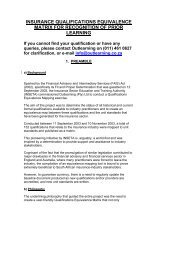• The fact that the industry has experienced job losses over the last few years due to the inability of existing brokers to comply withthe FAIS Fit and Proper requirements;• Brokers/intermediaries are reassessing their roles in the sector. More brokers are expected to leave the sector as they realise thatthey will not be able, or will not be willing, to comply with the legislative requirements. However, many brokers will also most likelyrededicate themselves to the sector;• Increased costs – the high cost of compliance will force brokerages to merge or close down;• The sector is considered a high-risk sector in which to operate – for example, there is significant risk to the broker if he/she offersbad advice or service.Another important issue is the fact that financial service providers struggle to understand the Fit and Proper requirements and toaccess the correct training that will enable them to become licensed. At the same time the FSB is concerned that the currentrequirements, that are based on formal qualification and credits towards qualification are not really developing the competencies thatare needed to ensure the expected level of service. They therefore instituted a forum of representative bodies to reconsider theway in which competence and operational ability can be tested for licensing purposes. 24Despite all the concerns mentioned above, the general view is that in the long term the FAIS Act will enhance the professionalismof the sector and will compel organisations and individuals to invest in the development of skills.Black economic empowermentSince 1994, a number of Acts pertaining to social transformation, the eradication of the effects of previous discriminatory legislationand practices, black economic empowerment and employment equity have been promulgated. They include the Employment EquityAct (No. 55 of 1998), the Preferential Procurement Framework Act (No. 5 of 2000) and the Broad-Based Black EconomicEmpowerment (BBBEE) Act (No. 53 of 2003). The BBBEE Act was followed by the development and adoption of a series of sectorcharters. Organisations in the sector are directly affected by the Financial Sector Charter, which was implemented in 2004, and thedraft Health Care Charter, which is currently still under discussion.The Financial Sector Charter (FSC) commits organisations in the sector to certain levels of black 25 and black female representationat all management levels in the insurance sector by 2008, which is over and above specific targets for board representation, ownership,procurement, servicing of the needs of the lower LSM groupings, and so on. The FSC also calls for minimum expenditure on trainingand skills development and sets industry-specific learnership targets. A summary of the FSC targets has been attached as AnnexureB to this report.Medical schemes will be significantly affected by the Health Care Charter once it is adopted by the sector. At the moment, however,this charter is still in draft form and no specific targets have been agreed upon.All the developments cited above were followed by the development and publication in 2006 of the Codes of Good Practice. TheCodes provide a standard framework for the measurement of broad-based BEE across all sectors of the economy 26 .Proposed changes to life insurance industry and the structure of commission paid to intermediariesIn June 2005, the Life Offices Association (LOA), which represents the majority of long-term insurers in South Africa, tabled a discussiondocument with the National Treasury, the Financial Services Board and various other industry organisations in which the LOA proposedfundamental changes to the current regulations regarding upfront commissions on long-term insurance policies, including endowmentsand retirement annuities. This discussion document followed on various developments and events that compelled the subsector toreconsider the total cost structure of long-term policies. These developments and events include:• determinations by the Pension Funds Adjudicator on retirement annuities that challenged the basis on which long-term insurerscalculate early termination values (and to a lesser extent also maturity values),• concerns expressed by the National Treasury and the Financial Services Board about the cost structure of long-term policies andthe fact that such a large portion of the costs is incurred at inception,• an increase in the number of policyholder complaints and extensive negative publicity on early termination policy values. 27In essence, the proposals include the replacement of the current regulated upfront commission with an ongoing commission consistingof two components, namely a sales commission and a service commission. Other proposals are that clients should be free to negotiateall commissions and should have full control over service commissions.The proposals put forward by the LOA were followed in March 2006 by the publication by the National Treasury of a discussion paperon contractual savings in the life insurance industry. This discussion paper covers a wider range of issues pertaining to the life insurancesector, including24 Personal interview with Ms Wendy Hattingh and Charene Nortier, Financial Services Board, 12 July 2007.25 “Black” refers to the African, coloured and Indian population groups.26 Department of Trade and Industry, Broad-Based Black Economic Empowerment Act – Interpretative Guide to The Codes of Good Practice, Pretoria, 2007.27 Life Offices Association, LOA Discussion Paper on Costs and Commission Structures for Long-Term Insurance Savings Policies. http:// www:.loa.co.za, June 2005.<strong>INSETA</strong> Sector Skills Plan - page 7
• insurer costs and equity concerns• competition (or the lack thereof) in the long-term insurance market• disclosure standards• the need for simplified products• the need for consumer education• governance arrangements for retirement annuity funds• intermediary relationships with insurers and with consumers• regulation of commission and advisory fees and• minimum early termination values of policies. 28At the time of writing this <strong>SSP</strong>, the issues relating to the life insurance industry were still being debated and no decisions had beentaken. However, professional bodies as well as individual brokers who participated in the <strong>SSP</strong> discussions were of the opinion thatthe proposed changes to the structure of the commission payable to intermediaries would result in the already beleagueredintermediary component of the sector becoming under even more pressure. A movement away from the upfront commissionstructure will specifically affect the cash flows of intermediaries, and, given the increased cost and stringent liquidity requirements laiddown in the FAIS Act, this may be the factor that finally drives some (especially smaller) brokers out of business. It may also lead toconsolidation, joint ventures , alliances or acquisition of smaller companies by larger ones. 29b) Economic factorsEconomic trends and circumstances and factors influencing economic growth or decline differ for the respective subsectors. For thisreason, the main subsectors are discussed separately.Long-term insuranceFigure 1-5 Trends in net premium incomes of life insurers*: years ended 31 December 2001-2006*Includes typical insurers, niche insurers and cell captive insurers.** 2000 values calculated by using the CPISources: Financial Services Board, Special report on the results of the long-term insurance Industry for the periods ended December 2004, (15 February 2005), December2005 (15 February 2006) December 2006 (15 February 2007).Various indicators of the general health of the long-term insurance sector are available. The movement in one of these indicators,net premium income, is illustrated in Figures 1-5 to 1-7. Figure 1-5 shows a decline of 11% in nominal and 24% in real terms for lifeinsurers over the period 2001 to 2004. In 2005 premium income increased again, but the real income of this part of the sectorremained 16% below the 2001 income level. On 2006 the real net premium income increased further and regained its 2001 level.A similar negative trend is observed between 2001 and 2004 in the real net premium income of link investment insurers. Althoughpremium incomes increased somewhat in 2005, it remained 22% below the 2001 level. In 2006 the upward trend continued andexceeded the 2001 level (Figure 1-6).The only component of the long-term subsector that experienced growth in net premium income over the period 2001 to 2005 isthe assistance insurers (mainly funeral policies) which experienced growth of 148% in nominal terms and 102% in real terms.However in 2006 nominal premium income declined by 8% and real premium income by 13% (Figure 1-7)28 National Treasury, Contractual Savings in the Life Insurance Industry, Pretoria, March 2006.29 PriceWaterhouseCoopers, Emerging Trends and Strategic Issues in South African Insurance, 2006.<strong>INSETA</strong> Sector Skills Plan - page 8
















